Nippon News Volume 2 Issue 5
IMPORTANT NOTES ABOUT PICTURES: you can usually get a larger photo for viewing in any blog entry by double-clicking on the image. Also, for this particular edition, the quality of photos is not up to the usual standard, given the distance from the ring, (the actual view is seen by the overall scene in photo #5), the fact that the subjects were often moving rapidly, and the difficult interior lighting available.
Sumo! You have to love any sport where the name of a competition is a 'basho-o'; (at least, that's what it sounds like when pronounced!) This sport is one of the enduring icons of Japan. And so. with the 15-day New Year National Tournament now on in Tokyo, we simply had to take in the action. This uniquely Japanese form of wrestling has a simple objective; two fighters square off in a 15-foot circle, and try to either throw the other out of the ring, or force a part of your opponant's body (other than the feet) to the ground. Most 'fights' are over in seconds; there are no weight or age categories, and there are only six such tournaments held annually; (three in Tokyo, and one each in Osaka, Nagoya and Kyushu). To Western eyes, this is a strange sport, indeed. But to dismiss Sumo without understanding it would be a great mistake; it is filled with ritual and deep meaning, and it is a facinating blend of the physical, mental, social, historical, and spritual makeup of the Japanese people themselves.
Sumo is to Japan what hockey is to Canadians, (except that I suspect that most Japanese have nev er wrestled Sumo style). The sport has historical roots stretching back for some 1,500 years, and has existed in its current form for more than 400 years. The original form of Sumo had religious significance; it was meant as a ritual dedicated to the gods with prayers in order to assure a bountiful harvest. These matches took place within the grounds of shrines, and were performed along with sacred dances and dramas. Eventually, the wrestling matches became a favoured method of training fighting men for the defense of the shogun. Finally, in 1603, with the outlawing of punching, kicking, eye gouging and choking, the wrestling matches became more of a sport for entertaining the masses and has remained as such ever since.
er wrestled Sumo style). The sport has historical roots stretching back for some 1,500 years, and has existed in its current form for more than 400 years. The original form of Sumo had religious significance; it was meant as a ritual dedicated to the gods with prayers in order to assure a bountiful harvest. These matches took place within the grounds of shrines, and were performed along with sacred dances and dramas. Eventually, the wrestling matches became a favoured method of training fighting men for the defense of the shogun. Finally, in 1603, with the outlawing of punching, kicking, eye gouging and choking, the wrestling matches became more of a sport for entertaining the masses and has remained as such ever since.
The bouts take place on an 18-foot square clay platform (calle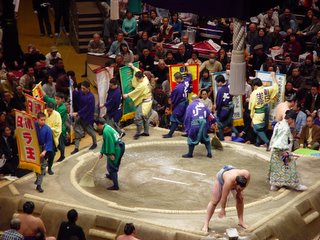 d a dohyo) that is raised 2 feet and with with loose sand piled on top. Inside of this square, the dohyo, a 15-foot inner circle, is inscribe by burying rice bags in the clay to leave a raised lip that serves as the actual fighting ring. Two more bags are placed in the middle, to mark the start position for the fighters (the rikishi). The rice bags at the north, south east and west sides of the circle are set back slightly; this was originally to allow drainage for outdoor matches, but this is retained now for tradition since these features are incorporated into the tactics used by the rikishi, (fighters). A view of the Doyho, (ring); with a figher preparing in his corner, sponsors parading their signs and the ring being swept. The judge is at the right.
d a dohyo) that is raised 2 feet and with with loose sand piled on top. Inside of this square, the dohyo, a 15-foot inner circle, is inscribe by burying rice bags in the clay to leave a raised lip that serves as the actual fighting ring. Two more bags are placed in the middle, to mark the start position for the fighters (the rikishi). The rice bags at the north, south east and west sides of the circle are set back slightly; this was originally to allow drainage for outdoor matches, but this is retained now for tradition since these features are incorporated into the tactics used by the rikishi, (fighters). A view of the Doyho, (ring); with a figher preparing in his corner, sponsors parading their signs and the ring being swept. The judge is at the right.
Tokyo boats a stadium tailor-made for Sumo with tickets going for $80 each for a seat about mid-bowl. The best seats, naturally, are ring-side, but the issue here is that all of the seating in the lower bowl is confined to simple matts; very uncomfortable for  those not used to sitting that way for long periods of time. Sumo is an all-day event, with preliminary matches by the lower ranks starting about 8:30 am, and concluding at 6 pm with the elite division. The outside of the stadium is conjested all day, with admiring throngs gathered to witness the arrival and departure of the wrestlers. The exterior of the stadium is decorated with colorful banners bearing the names of the top wrestlers. The special drumming tower and banners outside of the stadium [at the right].
those not used to sitting that way for long periods of time. Sumo is an all-day event, with preliminary matches by the lower ranks starting about 8:30 am, and concluding at 6 pm with the elite division. The outside of the stadium is conjested all day, with admiring throngs gathered to witness the arrival and departure of the wrestlers. The exterior of the stadium is decorated with colorful banners bearing the names of the top wrestlers. The special drumming tower and banners outside of the stadium [at the right].
Inside the stadium it is a relaxed affair, with people watching the matches, strolling around to visit the concession stands, souvenier shops and the on-site museum; lounging in the sun on the upper deck for a break, or going down to the entrance gate to view the arrival and departures of the Sumo. The wrestlers are very much visible; we rode the subway train with one of them, while others sit in the foyer or around the lower concourse before or after matches. While some will talk to fans and pose for pictures, I note that people are very respectful of  them and will not disturb them if they appear to be focused on their competition. [Left] Me, watching a Sumo and his valet arrive at the stadium.
them and will not disturb them if they appear to be focused on their competition. [Left] Me, watching a Sumo and his valet arrive at the stadium.
The concessions sell soft drinks, beer and cold sake at very reasonable prices. There is also popcorn, hot dogs, sausages, steamed buns and even french fries. More traditionally, there are Bento Boxes available; these contain a variety of cold Japanese delicacies such as rice rolls and fish. If you like, there are restaurants onsite for Ramen (noodle soup) or a choice of hot meals. Souveniers include everything from beer glasses, t-shirts, playing cards, calendars, to special chocolates shaped like wrestlers!
Meanwhile, the stadium also features large pictures of the winners of the past 32 tournaments hung from the rafters. Directly above the Doyho is suspended a large wooden structure that looks like a Shinto Shrine; a visible reference to the origins of the sport. Hung from each of the corners of the roof are large tassels re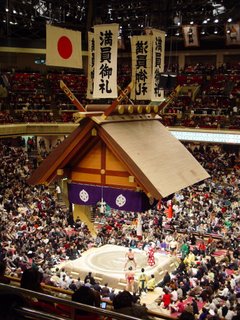 presenting each of the seasons. The competitors are ranked by ability; not age, weight, height or any other ciriteria. There are strict codes of behavior, dress and even hairstyle accorded to each of the classes of fighters, with the top man, (or men). alone allowed to carry the title of yokozuna (i.e. the top dog). In the 400 years of Sumo there have been fewer than 70 men awarded this exhaulted level; the person must have won at least two consequetive National Tournaments, have turned in consistent winning performances in recent years, and be a man of suitable qualities to even be considered for this title. The title of Yokozuna is granted for the duration of the Sumo's career; if he begins to lose consistently he is expected to retire. However, if you make to the top of the heap, you can expect an income of $28,000 (CDN) a month, and plenty more from your many private sponsors for endorsements, appearances and the like. Pretty good, even if you have to wear only a towel!
presenting each of the seasons. The competitors are ranked by ability; not age, weight, height or any other ciriteria. There are strict codes of behavior, dress and even hairstyle accorded to each of the classes of fighters, with the top man, (or men). alone allowed to carry the title of yokozuna (i.e. the top dog). In the 400 years of Sumo there have been fewer than 70 men awarded this exhaulted level; the person must have won at least two consequetive National Tournaments, have turned in consistent winning performances in recent years, and be a man of suitable qualities to even be considered for this title. The title of Yokozuna is granted for the duration of the Sumo's career; if he begins to lose consistently he is expected to retire. However, if you make to the top of the heap, you can expect an income of $28,000 (CDN) a month, and plenty more from your many private sponsors for endorsements, appearances and the like. Pretty good, even if you have to wear only a towel!
There are 4 lower classes of the elite level; with Ozeki being next only to the Yokozuna in rank. This is followed by Sekiwake, Komusubi, and then by Maegashira. Only some 40 fighters in total of the 800 make up these ranks; the rest are lower on the scale and are accorded less distinctive hairstyles, fighting dress, and other privl eges. In such a tournament, fighters have one bout on each of the 15 days, and the schedule is only made up 2 days in advance, in order to ensure that an overall winner can be declared in each of the categories at the conclusion at the conclusion of the tournament. The elite division fieaturing fighters of the top five ranks begins about 4 pm, with entry onto the dokyo of all competitors who will wrestle on that day in a ceremony called the doko-iriori [ring entering]. Each contestant enters by rank wearing a colorful silk cermonial apron called a kesha-mashi given to him by a supporters group or sponsor when he achieved an intermediate level ranking. Costing a minimum of $5,000 each, these aprons can become astronomical in price as the wrestler advances; becoming adorned with gold, silver and precious jewels. Above, the rikishi wearing their colourful aprons [kesha-mashi] prior to the final round for the day.
eges. In such a tournament, fighters have one bout on each of the 15 days, and the schedule is only made up 2 days in advance, in order to ensure that an overall winner can be declared in each of the categories at the conclusion at the conclusion of the tournament. The elite division fieaturing fighters of the top five ranks begins about 4 pm, with entry onto the dokyo of all competitors who will wrestle on that day in a ceremony called the doko-iriori [ring entering]. Each contestant enters by rank wearing a colorful silk cermonial apron called a kesha-mashi given to him by a supporters group or sponsor when he achieved an intermediate level ranking. Costing a minimum of $5,000 each, these aprons can become astronomical in price as the wrestler advances; becoming adorned with gold, silver and precious jewels. Above, the rikishi wearing their colourful aprons [kesha-mashi] prior to the final round for the day.
After a short cermony honouring the gods, the fighters then adjorn from the ring, allowing the yokozuna to make a grand entr ance, accompanied by two other fighters, one carrying a sword. Joining them in the ring is the referee-in-chief, wearing his special komono and carrying his symbol of office, the fan with the red tassel. On his head the yokozuna wears a massive, 35-pound hemp headgear found in Shinto shrines. As the others crouch in the ring, the yokozuna will then perform with the greatest dignity the dohyo-iri; a ritual that will also be performed by each of the fighters before their bouts. First clapping his hands to attract the attention of the gods, the fighter then raises both hands with palms outstrectched to show that he conceals no weapons. Next, he raises one leg as high as he can, and firmly stomps the ground to drive evil spirits from the dokyo. This same process is repeated and after a bow the yokozuna retires from the stage. The Yokozuna and his retinue, performing the dohyo-ri before the final round of competition for the day.
ance, accompanied by two other fighters, one carrying a sword. Joining them in the ring is the referee-in-chief, wearing his special komono and carrying his symbol of office, the fan with the red tassel. On his head the yokozuna wears a massive, 35-pound hemp headgear found in Shinto shrines. As the others crouch in the ring, the yokozuna will then perform with the greatest dignity the dohyo-iri; a ritual that will also be performed by each of the fighters before their bouts. First clapping his hands to attract the attention of the gods, the fighter then raises both hands with palms outstrectched to show that he conceals no weapons. Next, he raises one leg as high as he can, and firmly stomps the ground to drive evil spirits from the dokyo. This same process is repeated and after a bow the yokozuna retires from the stage. The Yokozuna and his retinue, performing the dohyo-ri before the final round of competition for the day.
There will be a single judge in the ring, who will preside over the competition and who will call the winner of the bout. He is supported by four other judges who side on the sidelines and observe; they can confer at any point to determine by vote the winner of a fight. The ring judge wears colorful clothing from the Edo era and carries a fan with a silk tassel and wears special sandals to signify his rank. The two fighters then appear, clad only in their silken loincloth, called a mawashi. As a symbol of their standing within their category, rikishi of the top quarter of their group are entitled to wear tassles with small balls attached to their loincloth. Each fighter also wears a special hair-do and topnot signifying their rank and standing. All of these costumes and hair-do's come from styles popular in Japan in the 1600's and unchanged since.
Immediately after entering the doyho each rikishi goes throug h a series of ritualistic movements. To cleanse f=both body and soul he smmbolically rinces his mouth with water, (offered by the winner of the previous bout), and wipes his body with a towel. Then he will repeat the doko-ririo by clapping and raising his hands and then feet, and stomping the ground [at right]. The top category of fighters alone is allowed to throw salt onto the dokyo to insure against injury. The Sumo then squats on his mark in the middle of the ring, and both fighters repeat the ceremony simultaneous, each trying to psyche out the other with the force of the movements and the agility of their extremeties. The referee oversees the ceremony, holding his fan at the side. With both fight
h a series of ritualistic movements. To cleanse f=both body and soul he smmbolically rinces his mouth with water, (offered by the winner of the previous bout), and wipes his body with a towel. Then he will repeat the doko-ririo by clapping and raising his hands and then feet, and stomping the ground [at right]. The top category of fighters alone is allowed to throw salt onto the dokyo to insure against injury. The Sumo then squats on his mark in the middle of the ring, and both fighters repeat the ceremony simultaneous, each trying to psyche out the other with the force of the movements and the agility of their extremeties. The referee oversees the ceremony, holding his fan at the side. With both fight ers squatting, the bout will begin once both touch their hands to the ground while the referee is holding his fan towards the men. However, this pre-fight phase is full of false starts, restarts, and features the men glaring at the other, striking the ground forcefully, and otherwise attempting to gain the psychological advantage over their opponant. The men have just 4 minutes to begin the actual bout, and most take full use of it. At left, a fighter throwing salt onto the ring as a ritual to avoid injury.
ers squatting, the bout will begin once both touch their hands to the ground while the referee is holding his fan towards the men. However, this pre-fight phase is full of false starts, restarts, and features the men glaring at the other, striking the ground forcefully, and otherwise attempting to gain the psychological advantage over their opponant. The men have just 4 minutes to begin the actual bout, and most take full use of it. At left, a fighter throwing salt onto the ring as a ritual to avoid injury.
With both men crouched and the referee holding his fan at them, the instant the second man puts his hand on the ground they will each lunge at the other, attempting to grasp their opponant's loincloth. Pure power might win with one man bulling the other out of the ring or even picking the fighter up and depositing him on the other side of the circle. There might be a side throw with a fighter tossing the other into the crowd or on his back. At times a fighter might side-step a lunge and push the opponant to the ground, or onto his back. There could be a standoff with each man grabbing the other mid-ring and maneuvering for advantage. A fighter might be even be perched on top of the rice-bag, but unless he is force beyond it, the contest continues. Slapping and tripping in allowed, and in the end the judge points to the winner, who then squats in the ring, while the other bows to the victor, and departs. At the elite level the judge awards a cash prize to the winner, who will then leave the ring with a bow to the doyho before retiring. At right, the set position.
onto his back. There could be a standoff with each man grabbing the other mid-ring and maneuvering for advantage. A fighter might be even be perched on top of the rice-bag, but unless he is force beyond it, the contest continues. Slapping and tripping in allowed, and in the end the judge points to the winner, who then squats in the ring, while the other bows to the victor, and departs. At the elite level the judge awards a cash prize to the winner, who will then leave the ring with a bow to the doyho before retiring. At right, the set position.
It is all great fun, with favourites winning and losing, and the crowd cheering on their fighter, as, one-by-one, the daily contests take place. Normally, all of the top fights take place in the last half-hour; from 5:30 until 6:00 pm. . At the end of the day, the yokizuna again enters the ring,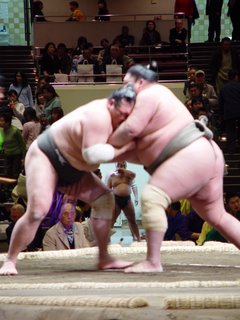 to be handed a bow by the judge. This he twirls, balances, and uses to entertain the crowd for a few minutes, to thank them for coming. this again is an old ritual that first occured when a champion was awared an actual bow as a prize.
to be handed a bow by the judge. This he twirls, balances, and uses to entertain the crowd for a few minutes, to thank them for coming. this again is an old ritual that first occured when a champion was awared an actual bow as a prize.
At the end of the day, special drummers outside the stadium play from a tower that is constructed near the stadium. Much of the crowd then adjorns to one of the many nearby bars and restaurants, (many of them owned by former Sumos), to eat, drink and celebrate while reliving the contests and speculating on the day to come. Sumo is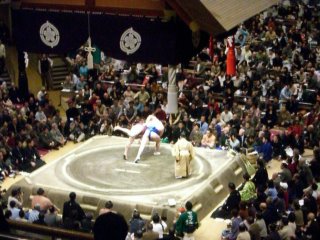 supreme here in Japan, and I would recommend it as a very unique sport to watch for anyone lucky enough to be able to attend such a tournament. Above; the clash, and then, (directly above), the ending, which in this case is the outcome of a throw.
supreme here in Japan, and I would recommend it as a very unique sport to watch for anyone lucky enough to be able to attend such a tournament. Above; the clash, and then, (directly above), the ending, which in this case is the outcome of a throw.
Sited along the way:
In Japan, even the ordinary is often interested. In this case, shoppin g in the local supermarket:
g in the local supermarket:
- an exterior shop of a corner store with six, (count-em), vending machines available for your use;
- a fresh pastry; the Japan
 ese absolutely love their sweets. Pastry shops are everywhere, but not a single Tim Horton's!
ese absolutely love their sweets. Pastry shops are everywhere, but not a single Tim Horton's!
- an individually-wrapped carrot on display; the Japanese insist on top-quality food, and are willing to pay for th
 at privledge;
at privledge;
canned coffee; you just pull the little ring to open it and a catalytic reaction delivers you instant and hot coffee at any hour of the day or night. This particular one, made by the Aishii Brewing Company, is called Wonda Shot & Shot. (I think it shoud have a question mark at the end of that phrase). It has alcohol in it, and the label notes that it is 'The Fine Taste For Over 30's Crowd'. I guess we 'oldsters' need that extra 'push' to get going in the morning!
- Fish? Nope! More doughnuts - just shaped like fish!
- Two 3-packs of sliced bread. Who would want 3 slices? Well, remember that four is an unlucky number in Japanese culture! Thats why! I have seen packages of 5,6 and 8 slices; all without crusts! But NEVER 4 slices.
- I am not sure what this is, but it tastes G-G-G-R-R-E-E-A-A-T!! Tony The (Asian) Tiger is obviously bilingual.
Doug-San In Japan
Saying Sayonara for now!

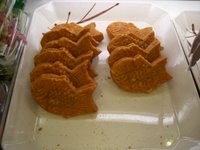



0 Comments:
Post a Comment
<< Home